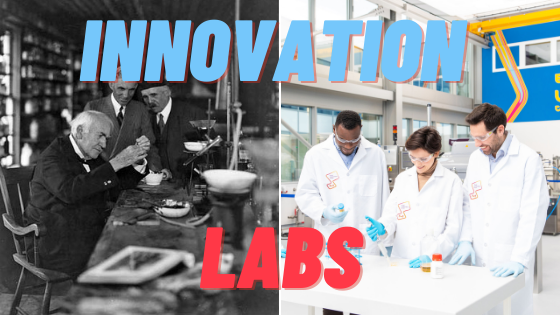Edison’s greatest gift to mankind was his creation of commercial Research & Design labs. In his invention factory at West Orange, Edison taught us that R&D is a risk reduction process, reducing the risk of launching new products! It eventually fostered the realization that the United States economy and progress is technology driven.
Edison’s invention factory building had many lab rooms available for the development of a wide variety of new products contemplated by the great inventor. He once said that he could make anything from a lady’s watch to an automobile in this factory. Each room was a safe haven for ideas and prototypes to be tested and evaluated using his team-based, interdisciplinary, problem solving philosophy. Students today practice the Edison hands-on philosophy when they study STEM and participate in maker labs.

Edison personally put together each development team, carefully selecting the people with skills pertinent to the project at hand. Teams were encouraged to talk and intermingle and to be in a constant state of learning; with flexible work hours in effect. A large company library was available to help teams research their work, which is something modern research labs make extensive use of too.

At the invention factory, which was actually the first “maker space”, everything was set-up to quickly prototype new inventions…and you can see this first hand at the Thomas Edison National Historical Park today. Edison’s 250 member R&D staff kept the other 10,000 employees busy all year–long making and shipping new Edison products!
At any given time, there may have been 30 to 40 rooms and separate teams in operation to keep the Edison new product pipeline full and productive. In Room 5, the motion picture was invented and developed while other rooms were constructed in the courtyard just to tackle his craziest ideas.
In fact, the original Bell Labs was set-up in a similar manner. In the photo below, you can see the many researchers and lab facilities sorted into separate rooms for separate projects from the first lasers and transistors to computing technologies like satellites.

Within his lifetime, Edison witnessed how major corporations in the world adopted his R&D philosophy and like Bell Labs, set up their research facilities based around their product development teams. Academic labs in top universities also follow this special teams/lab geometry, easily recognized in their research facilities.
Between the time Edison’s West Orange lab was created in 1887 and 1929, many of the great American companies we recognize today started their R&D departments…helping to unleash a torrent of new products, services and of course, patents:
- Johnson & Johnson: 1891
- Merck: 1891
- National Starch: 1895
- Du Pont: 1903
- Westinghouse: 1904
- Benjamin Moore: 1904
- Exxon: 1919
- RCA: 1920
- Englehard: 1920
- Union Carbide: 1925
- Bell Labs: 1925
- Mobil: 1925
- Hoffman La Roche: 1929
However, the innovation didn’t end there. Thomas Edison would be impressed by how these inaugural R&D departments have turned into large-scale, dedicated innovation labs that drive our nation’s economy. Silicone Valley is filled with state-of-the-art facilities like the Palo Alto Research Center and the Ford Research and Innovation Center that bring leading scientists, engineers, and designers together to spark creativity and create new technology.
Google X describes their lab as, “X is a diverse group of inventors and entrepreneurs who build and launch technologies that aim to improve the lives of millions, even billions, of people.” If you can look past the modern, all-white labs of today…this sounds exactly like the Thomas Edison West Orange Invention Factory to me!


